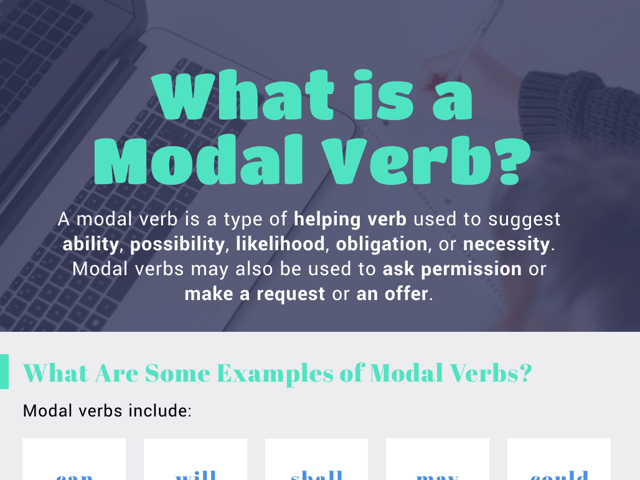
What Is a Modal Verb?
Modal verbs. What on earth is a modal verb?! A “model” verb would be a perfect specimen of a verb, but a “modal” verb? Let’s explore…
First, the Definition
A modal verb is a type of helping verb used to suggest ability, possibility, likelihood, obligation, or necessity. Modal verbs may also be used to ask permission or make a request or an offer.
What Are Some Examples of Modal Verbs?
Modal verbs include: can, will, shall, may, could, would, should, might, and must. They work with another verb in a sentence to clarify or change the meaning somehow.
How Do They Work?
Here are some examples of modal verbs at work in sentences.
| Original Sentence | Purpose of the Modal Verb |
Resulting Sentence |
|---|---|---|
| Joe drives a car. | to suggest ability | Joe can drive a car. |
| Sally goes to the store. | to suggest possibility or likelihood |
Sally might go to the store. |
| Celia goes to the dentist. | to suggest obligation or necessity |
Celia should go to the dentist |
| I close the door. | to ask permission or make a request |
May I close the door? |
As you can see, with the insertion of a modal verb, the meaning and/or purpose of the sentence is changed slightly.
What Are the Rules for Modal Verbs?
Modal verbs function under three basic rules:
1. Modal verbs never change their form
Use them exactly as they appear. It doesn’t matter if a modal verb is being used in the past, present, or future, the form remains the same.
Mike can balance a spinning basketball on each hand at the same time. (present)
Molly could balance a ball when she was two. (past)
Our school’s team will balance balls during the game break on Saturday. (future)
2. Modal verbs have no infinitives (“to” form of a verb) and no participles (“-ing” verbs being used as adjectives).
This means you should always use the base form of a verb after a modal and not conjugate it in any way.
Seth shall carry the banner.
Layla must study for her test.
Jordyn and Tad should sit together at lunch.
3. To make a negative when using a modal, use “not” after the modal to make it negative.
Don’t try to stick not in other places by using words like don’t, wasn’t, aren’t, etc.
Correct: You should “not” touch the wasp’s nest.
Incorrect: You can’t should touch the wasp’s nest.
You may use the modal to create a negative contraction, but until you are comfortable doing so, spell them out as separate words.
You shouldn’t touch the wasp’s nest.
He can’t tell time on an analog watch.
They mustn’t speak while the teacher is talking.
How Does All of This Affect Me?
Modal use is quite common and you’ve probably engaged with them without even knowing it. And it’s doubtful that you are going to be asked to define the term modal verb any time soon. However, understanding what modal verbs are, so you know when and how to use them, can help ensure that your sentences remain grammatically correct.

Keep Reading

TOEFL Test Blog
Is the TOEFL Test Hard?
The TOEFL test, or Test of English as a Foreign Language, is one of the…

TOEFL Test Blog
What’s New for the TOEFL® Test?
The TOEFL® test is designed to measure English proficiency in speaking,…

TOEFL Test Blog
Six Tips for Doing Well on the TOEFL® Speaking Test
The Speaking section of the TOEFL® may be one of the more nerve-wrackin…